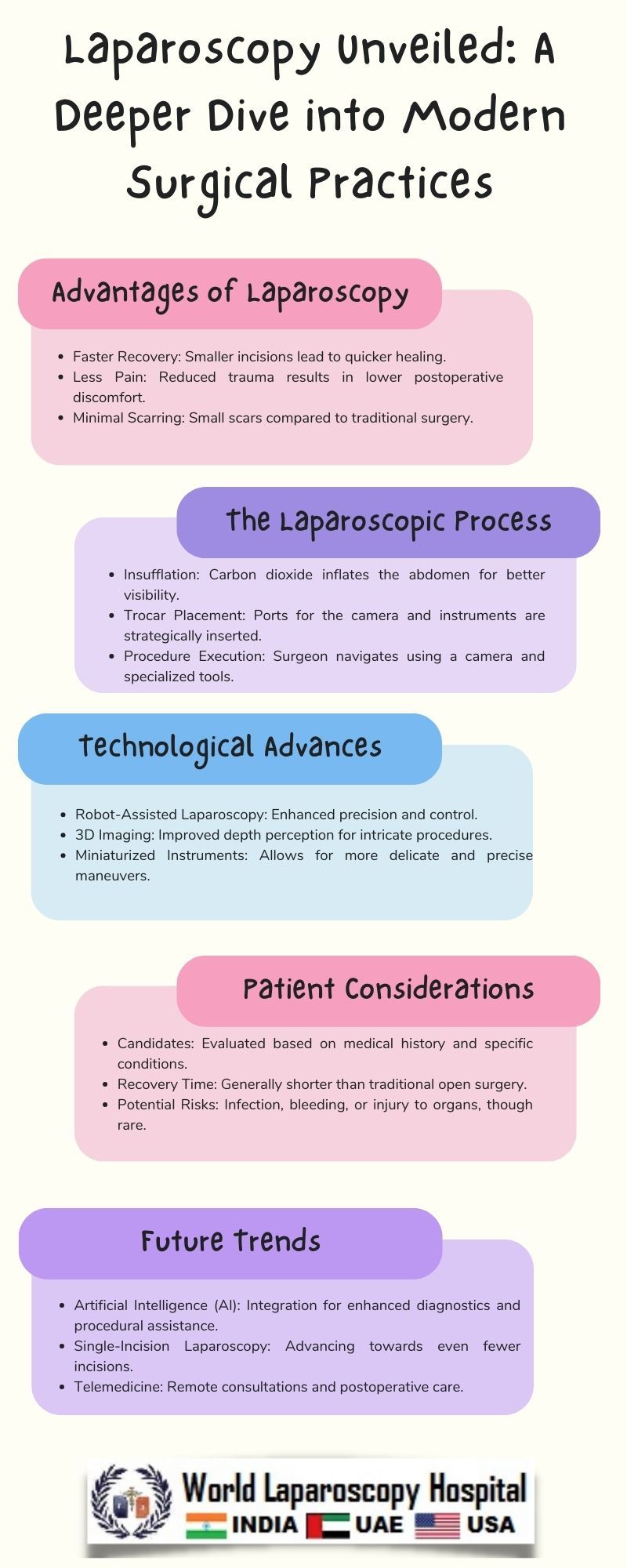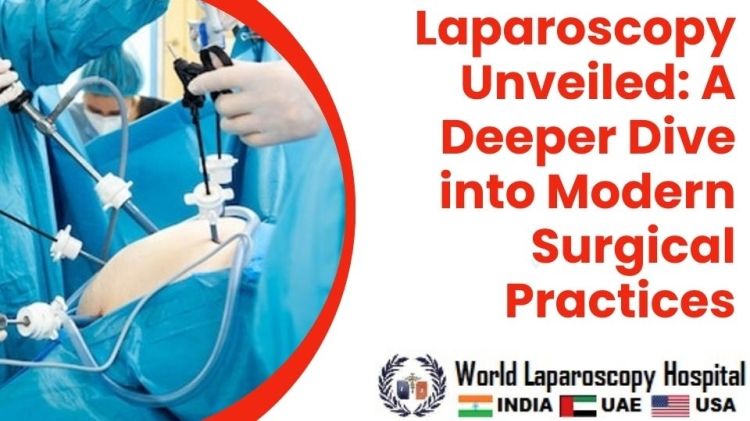Laparoscopy Unveiled: A Deeper Dive into Modern Surgical Practices
Introduction
In the ever-evolving landscape of medical science, technological advancements continually shape and redefine traditional practices. One such transformative innovation that has revolutionized surgical procedures is laparoscopy. This minimally invasive technique, also known as keyhole surgery, involves making small incisions through which specialized instruments and a camera are inserted. The aim? To provide a detailed exploration of the inner workings of laparoscopy and its profound impact on modern surgical practices.

Evolution of Surgical Techniques
Historical Context of SurgeryTo appreciate the significance of laparoscopy, it's essential to glance back at the historical context of surgery. Traditional open surgeries, with long incisions and extended recovery times, were the norm. Surgeons navigated through layers of tissue, often causing significant trauma to the patient's body. The quest for less invasive methods and faster recovery spurred the exploration of alternatives, leading to the development of laparoscopy.
Inception of LaparoscopyThe concept of laparoscopy dates back to the early 20th century, but its practical application began in the 1970s. The initial procedures were rudimentary, focusing on diagnostic exploration rather than complex surgeries. Over time, technological advancements and surgical expertise converged, propelling laparoscopy into the forefront of modern surgery.
Key Components of Laparoscopy
InstrumentationThe cornerstone of laparoscopy lies in its specialized instruments. Trocars, cannulas, and laparoscopes equipped with high-resolution cameras enable surgeons to navigate and visualize the internal organs with precision. The dexterity of these instruments allows for intricate maneuvers within the confined space of the body.
Insufflation and PneumoperitoneumBefore delving into the intricacies of a procedure, surgeons create a pneumoperitoneum by insufflating carbon dioxide into the abdominal cavity. This lifts the abdominal wall away from the organs, providing a clear field of view and creating space for surgical maneuvers. The controlled environment enhances visibility and facilitates safe, precise interventions.
Advantages of Laparoscopy
Minimally Invasive NatureThe primary advantage of laparoscopy is its minimally invasive nature. Unlike open surgeries that necessitate large incisions, laparoscopic procedures involve small keyhole incisions. This results in reduced trauma to surrounding tissues, minimizing pain and accelerating recovery.
Faster Recovery TimesPatients undergoing laparoscopic procedures often experience shorter hospital stays and quicker recovery times compared to traditional surgeries. The reduced trauma to tissues and minimized scarring contribute to a swifter return to normal activities, enhancing overall postoperative quality of life.
Cosmetic BenefitsThe cosmetic aspect of laparoscopy cannot be understated. Small incisions translate to minimal scarring, a factor appreciated not only for aesthetic reasons but also for its psychological impact on patients. This aspect of laparoscopy has contributed to its widespread acceptance and preference among both surgeons and patients.
Applications Across Specialties
GynecologyLaparoscopy has become a cornerstone in gynecological procedures. From diagnostic explorations to complex surgeries like hysterectomies and ovarian cyst removals, gynecologists utilize the precision of laparoscopic instruments to address a myriad of conditions. The reduced impact on surrounding tissues is particularly advantageous in preserving fertility.
Gastrointestinal SurgeryIn gastrointestinal surgery, laparoscopy has transformed the landscape. Procedures like cholecystectomy (gallbladder removal), appendectomy, and bariatric surgeries are routinely performed using laparoscopic techniques. The benefits extend beyond the operating room, as patients experience shorter hospital stays and reduced postoperative pain.
UrologyUrological procedures, such as nephrectomy and prostate surgery, have witnessed a paradigm shift with the adoption of laparoscopy. The enhanced visualization and precision offered by laparoscopic instruments contribute to improved outcomes and reduced complications.
Challenges and Innovations
Learning CurveWhile laparoscopy offers numerous benefits, mastering the technique requires a significant learning curve. Surgeons must develop a new set of skills, including hand-eye coordination and spatial awareness, to navigate the confined spaces within the body. Training programs and simulations are crucial in ensuring surgeons acquire proficiency before performing live procedures.
Technological AdvancementsContinuous advancements in technology play a pivotal role in overcoming the challenges associated with laparoscopy. The integration of robotics, augmented reality, and artificial intelligence into laparoscopic systems enhances precision and expands the scope of minimally invasive procedures. These innovations are reshaping the future of surgery and pushing the boundaries of what is achievable through laparoscopy.
Future Directions
Robotic SurgeryThe marriage of robotics and laparoscopy has given rise to robotic-assisted surgery. Robotically controlled instruments, guided by surgeons from a console, offer unparalleled precision and dexterity. This evolution in surgical technology opens new frontiers, allowing for complex procedures with reduced invasiveness.
Artificial Intelligence in Surgical Decision-makingThe integration of artificial intelligence (AI) into laparoscopic procedures holds immense promise. AI algorithms can analyze real-time data from laparoscopic cameras, providing surgeons with insights and decision support during surgery. This collaborative approach between human expertise and AI has the potential to further enhance patient outcomes.
Ethical Considerations and Patient Perspectives
Informed Consent and Patient AwarenessAs with any medical procedure, informed consent is crucial in laparoscopy. Patients must be educated about the benefits, risks, and alternatives associated with laparoscopic procedures. Ensuring comprehensive awareness empowers patients to make informed decisions about their healthcare.
Access and AffordabilityWhile laparoscopy offers numerous advantages, access to these advanced procedures can be limited by factors such as geographical location and financial considerations. Addressing these disparities is essential to ensure that the benefits of laparoscopy are accessible to a broader population.
Conclusion
Laparoscopy stands as a testament to the relentless pursuit of innovation in the field of surgery. Its evolution from a niche diagnostic tool to a mainstream surgical technique has redefined the expectations and possibilities in modern medicine. As technology continues to advance, the future holds even greater promise for laparoscopy, with the potential to further enhance patient outcomes and redefine the boundaries of what is achievable in the realm of minimally invasive surgery.






